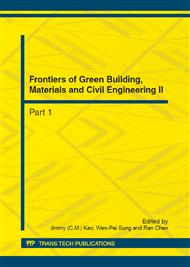p.919
p.925
p.931
p.935
p.939
p.949
p.954
p.958
p.964
Analysis of Soil Arch under Dynamic Load
Abstract:
Aroused by the differential stiffness of pile and soil, the upper load on subgrade is apt to be transferred to pile rather than soil among piles in pile supported embankment(soil arching effect), which optimizes the load-transfer path and effectively limits total settlement of the subgrade. In this paper the properties of soil arch under dynamic load have been investigated by performing numerical studies using the Finite Element Method. The influence of stiffness difference between soil and pile on the soil arch is also proposed in this paper. According to the calculation results, the softer the soil between piles is, the larger proportion of load imposes on pile. Dynamic load has negative effects on the static soil arch, but it does not ruin the shape of the arch. Simultaneously, the larger N (the ratio of dynamic modulus of pile to that of soil)is, the weaker the negative effects of dynamic load on static soil arch are. The static soil arch (soil arch formed when the model only bears static load) has optimized the load transformation path, leading more load undertaken by the pile. Besides, When the stiffness difference between pile and soil among piles is relatively small, the height of soil arch increases sharply with the decrease of N; while when the stiffness difference reaches some certain value, the further increasing of N has little influence on soil arch’s height.
Info:
Periodical:
Pages:
939-948
Citation:
Online since:
August 2012
Authors:
Price:
Сopyright:
© 2012 Trans Tech Publications Ltd. All Rights Reserved
Share:
Citation:


